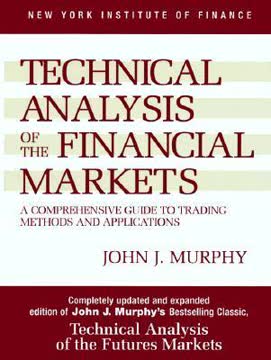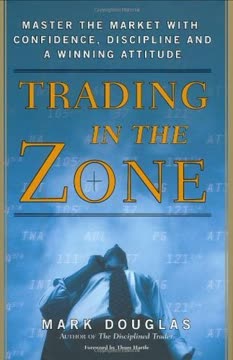Key Takeaways
1. Markets move due to supply and demand, not personal opinions
Markets don't move because they want to, they move because they have to.
Supply and demand drive markets. Prices rise when demand exceeds supply and fall when supply exceeds demand. This fundamental principle operates regardless of economic indicators, news events, or personal opinions. Traders must focus on actual market behavior rather than their own beliefs about where prices "should" go.
Emotional reactions fuel major moves. Markets often make sharp moves when enough traders get trapped on the wrong side of a trade. This creates a burst of fear, frustration, and panic buying or selling. Professional traders capitalize on these emotional reactions by positioning themselves on the opposite side.
Key drivers of supply/demand imbalances:
- Margin calls forcing liquidation
- Stop orders being triggered
- Psychological capitulation
2. Successful trading requires discipline and a professional mindset
Emotions are fine at weddings and funerals.
Control your emotions. Successful traders develop the ability to follow their trading plans without being swayed by fear, greed, or other emotions. This requires cultivating discipline and a professional mindset focused on consistent execution rather than individual trade outcomes.
Avoid common psychological pitfalls. Many traders sabotage themselves through destructive habits like overtrading, chasing the market, or holding losing positions too long. Recognizing and overcoming these tendencies is crucial for long-term success.
Key psychological challenges:
- Fear of missing out (FOMO)
- Inability to accept small losses
- Overconfidence after winning streaks
- Analysis paralysis
3. Set up your trading technology for optimal performance
If traders can get this part right, they are at least going to have a fighting chance to compete on a level playing field with everybody else.
Invest in reliable hardware and software. A trader's computer and execution platform are mission-critical tools. Invest in a high-performance system with ample RAM, multiple monitors, and robust backup solutions to avoid costly downtime or errors.
Maintain and secure your technology. Regularly update software, remove spyware, defragment hard drives, and implement cybersecurity best practices. This preventive maintenance helps ensure smooth operation during crucial trading hours.
Essential technology components:
- High-RAM computer (minimum 1GB)
- Multiple monitors
- Uninterruptible power supply (UPS)
- Reliable internet connection with backup
- Professional-grade charting and execution software
4. Understand market internals to gauge intraday direction
Musicians know how to read music; traders must know how to read the markets.
Monitor key market indicators. Successful intraday traders develop proficiency in interpreting various market internals like the TICK, TRIN, and Put/Call ratio. These indicators provide insight into the underlying buying and selling pressure driving price movements.
Use internals to confirm trade setups. Rather than relying solely on price action or technical indicators, incorporate market internals to validate potential trades and gauge overall market sentiment. This multi-faceted approach improves the odds of successful trades.
Important market internals to watch:
- NYSE TICK
- TRIN (Arms Index)
- Put/Call ratio
- Advance/Decline line
- Sector performance
5. Use specific setups to identify high-probability trades
Trading without a specific setup in mind is like hiking in the Amazon without a compass.
Develop a repertoire of proven setups. Successful traders focus on a handful of high-probability trade setups that align with their personality and risk tolerance. These setups provide a systematic approach to identifying potential trades across various market conditions.
Continuously refine and adapt setups. Regularly review the performance of your trade setups and make adjustments as market conditions evolve. Be willing to discard setups that stop working and explore new opportunities as they arise.
Example trade setups described in the book:
- Opening gap plays
- Pivot point trades
- Squeeze setups
- Brick plays
- HOLP and LOHP reversals
6. Implement risk management and position sizing strategies
Professional traders focus on limiting risk and protecting capital. Amateur traders focus on how much money they can make on each trade.
Define risk parameters for every trade. Before entering a position, determine your maximum acceptable loss and place a stop-loss order accordingly. This predefined risk helps prevent emotional decision-making during volatile market conditions.
Size positions appropriately. Avoid overleveraging by limiting position sizes relative to your total account equity. A common guideline is risking no more than 1-2% of your account on any single trade.
Key risk management principles:
- Use stop-loss orders consistently
- Avoid adding to losing positions
- Scale out of winning trades to lock in profits
- Implement proper position sizing
7. Develop a comprehensive trading plan and stick to it
Traders who want to maintain a competitive edge in this business must first be aware of the technological dangers facing them in today's world.
Create a detailed business plan. Outline your trading goals, strategies, risk management rules, and performance metrics. A well-crafted plan provides a framework for consistent decision-making and helps maintain discipline during challenging market conditions.
Regularly review and update your plan. Assess your trading performance on a weekly, monthly, and quarterly basis. Identify areas for improvement and adjust your plan accordingly. Be willing to adapt to changing market conditions while maintaining your core principles.
Essential elements of a trading plan:
- Trading goals and objectives
- Specific strategies and setups
- Risk management rules
- Position sizing guidelines
- Performance tracking and review process
- Continuous education and improvement plan
Last updated:
FAQ
What's Mastering the Trade about?
- Trading Psychology: The book emphasizes the psychological aspects of trading, focusing on how emotions can lead to poor decision-making and the importance of understanding one's mental state.
- Practical Techniques: John F. Carter provides proven techniques for intraday and swing trading setups, covering strategies with specific entry and exit points to maximize profits.
- Market Mechanics: It explains the basic mechanics of different markets, including stocks, futures, and forex, which is crucial for traders to navigate and profit from these markets.
Why should I read Mastering the Trade?
- Comprehensive Guide: The book serves as a comprehensive guide for traders at all levels, offering insights into trading psychology, market mechanics, and specific strategies.
- Real-World Examples: Carter uses real-world examples and case studies to illustrate concepts, making them relatable and easier to understand.
- Risk Management Focus: Emphasizes the importance of risk management and developing a trading plan, providing actionable advice on protecting capital and managing trades effectively.
What are the key takeaways of Mastering the Trade?
- Market Movements: Understanding that market movements are driven by human emotions and reactions, which traders must comprehend to succeed.
- Psychological Phases: Carter outlines three phases traders typically go through, helping them identify their current mindset and adjust strategies accordingly.
- Importance of Setup: Stresses the significance of having a specific trading setup and sticking to it, advising against impulsive decisions based on emotions.
What are the best quotes from Mastering the Trade and what do they mean?
- "Amateurs hope; professionals steal.": Highlights the difference between amateur and professional traders, emphasizing calculated actions over reliance on luck.
- "It's not the economy, stupid.": Suggests that market movements are driven by trader psychology rather than economic indicators, encouraging focus on market sentiment.
- "The financial markets are naturally set up to take advantage of and prey upon human nature.": Emphasizes the importance of understanding human psychology in trading.
How does Mastering the Trade address trading psychology?
- Emotional Awareness: Carter stresses that emotions can be detrimental in trading, encouraging traders to develop self-awareness and recognize their emotional impact.
- Professional Mindset: Suggests adopting a professional mindset, focusing on setups rather than outcomes, to manage emotions and make rational decisions.
- Trader Development Phases: Outlines psychological phases traders go through, aiding in personal development and improving trading performance.
What specific trading strategies are discussed in Mastering the Trade?
- Gap Trading: Discusses the "Opening Gap" strategy, providing rules for identifying high-probability gap trades and managing them effectively.
- Pivot Points: Covers using pivot points for both trending and choppy market conditions, explaining setup on charts and trading psychology.
- Scalping Techniques: Introduces scalping strategies for quick trades, emphasizing timing and execution in fast-paced trades.
What is the TRIN and how is it used in trading according to Mastering the Trade?
- TRIN Definition: The TRIN, or Arms Index, is a market breadth indicator measuring the relationship between advancing and declining stocks and their volume.
- Interpreting TRIN Values: A TRIN value above 2.0 indicates a high likelihood of a market rally, while a value below 0.60 suggests a potential sell-off.
- Practical Application: Traders can use TRIN readings to focus on long or short setups based on previous day’s values, aiding in trading decisions.
How does the put/call ratio work in trading as explained in Mastering the Trade?
- Understanding the Ratio: Compares the volume of put options to call options, providing insight into market sentiment.
- Key Thresholds: A put/call ratio above 1.0 signals extreme bearishness, while a ratio below 0.60 indicates extreme bullishness.
- Market Dynamics: Helps traders understand market participant positioning, allowing anticipation of potential reversals.
What are pivot points and how are they used in Mastering the Trade?
- Pivot Points Definition: Technical indicators used to identify potential support and resistance levels based on the previous day’s high, low, and close.
- Calculating Pivot Points: Involves using a simple formula that averages the previous day’s price action to determine key levels.
- Trading Strategy: Used to set entry and exit points, with traders looking for bounces or reversals at pivot points.
How can I apply the concepts from Mastering the Trade to my trading?
- Develop a Trading Plan: Carter stresses having a well-defined plan with specific setups, risk management strategies, and performance tracking.
- Practice Discipline: Encourages sticking to setups and avoiding impulsive decisions based on emotions, crucial for long-term success.
- Utilize Market Internals: Discusses using market internals like ticks and TRIN to gauge market direction, improving decision-making.
How does Mastering the Trade suggest managing risk?
- Set Stop Losses: Emphasizes using stop-loss orders to limit potential losses, with guidelines for determining appropriate levels.
- Position Sizing: Discusses the significance of proper position sizing to manage risk effectively, advising specific capital allocation per trade.
- Drawdown Rules: Recommends establishing daily and monthly drawdown rules to protect capital, suggesting cutting positions or halting trading if thresholds are exceeded.
What are the common mistakes traders make according to Mastering the Trade?
- Lack of a Plan: Entering the market without a clear trading plan leads to impulsive decisions and losses.
- Emotional Trading: Letting emotions dictate actions results in poor decision-making; maintaining control is advised.
- Overtrading: Warns against overtrading, especially in choppy markets, encouraging patience for high-probability setups.
Review Summary
Mastering the Trade receives mixed reviews. Some readers praise its insights on trading psychology and strategies, particularly the TTM Squeeze setup. Others criticize the book for promoting paid indicators and specific setups without proper explanation. Many find the content more suitable for day trading than swing trading. Some reviewers appreciate the author's candid approach and entertaining anecdotes, while others see it as a sales pitch. The book's value seems to depend on the reader's experience level and expectations, with beginners finding it more useful than experienced traders.
Similar Books










Download PDF
Download EPUB
.epub digital book format is ideal for reading ebooks on phones, tablets, and e-readers.




